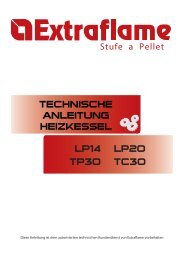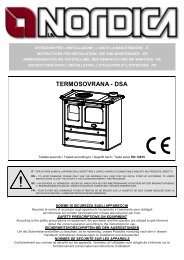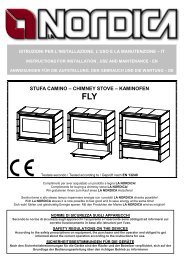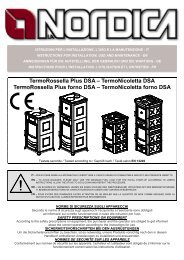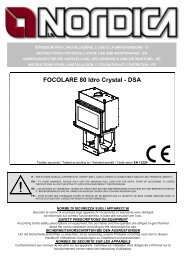1 - HJS-Internethandel
1 - HJS-Internethandel
1 - HJS-Internethandel
Create successful ePaper yourself
Turn your PDF publications into a flip-book with our unique Google optimized e-Paper software.
TERMOSUPREMA COMPACT DSA / ITALY TERMO DSA<br />
Type Kg/mc kWh/kg humidity 20%<br />
Beech 750 4,0<br />
Turkey oak 900 4,2<br />
Elm 640 4,1<br />
Poplar 470 4,1<br />
Larch* 660 4,4<br />
Norway spruce* 450 4,5<br />
Scotch pine* 550 4,4<br />
* RESINOUS WOOD UNSUITABLE<br />
CAUTION: The continuous and prolonged used of wood which is particularly rich in aromatic oils (e.g. Eucalyptus, Myrtle etc.)<br />
causes the sudden deterioration (flaking) of the cast iron components present in the product.<br />
8. IGNITION<br />
WARNING: For no reason turn on the fire before the system has been completely filled with water; doing this would lead serious<br />
damage to the entire structure. IABSOLUTELY DO NOT LIGHT THE FIRE IN THE THERMO-FIREPLACE IN THE TOTAL OR<br />
PARTIAL ABSENCE OF WATER (NOT EVEN FOR CHECKING), AS IT COULD BE IRREMEDIABLY RUINED. IN SUCH CASE THE<br />
WARRANTY ON THE APPLIANCE IS VOIDED.<br />
IMPORTANT: during the first ignition, it is inevitable that an unpleasant smell is produced (due to the drying of the adhesives in the sealing<br />
cord or the protective varnishes), which disappears after a short use. The environment must nevertheless be well ventilated. On<br />
first ignition, we recommend loading a reduced quantity of fuel and increasing the calorific power of the appliance.<br />
ATTENTION: during the first lightings there could be a solid smokes condensation with a small escape of water from the thermofireplace:<br />
this event will expire in a very short time but if it persists it will be necessary to check the chimney draught.<br />
To carry out a correct first ignition of the products treated with varnishes for high temperatures, it is necessary to know the following<br />
information:<br />
• the construction materials of the products in question are not homogeneous; in fact cast iron and steel parts exist side by side.<br />
• the temperature to which the body of the product is subjected is not homogeneous: from zone to zone, the temperatures recorded<br />
vary from 300 °C to 500 °C;<br />
• during its life, the product is subjected to alternate cycles of ignition and switch-off during the same day and to cycles of intense<br />
usage and complete rest as the seasons change;<br />
• the new thermocooker, before it can be defined as “tested”, must be subjected to various start up cycles in order to allow all the<br />
materials and the varnish to complete the various elastic stresses;<br />
• in particular at the beginning, it is possible to notice the emission of smells which are typical of metals subjected to great thermal<br />
stress and varnish which is still fresh. This varnish, despite being baked at 250°C for a few hours in the manufacturing process,<br />
must exceed the temperature of 350°C several times and for a certain duration, before incorporating itself perfectly with the metal<br />
surfaces<br />
It therefore becomes important to follow these small precautions in the ignition phase:<br />
1. Make sure that there is significant air turnover in the place where the appliance is installed.<br />
2. When lighting for the first few times, do not load the combustion chamber excessively (about half of the quantity shown in the<br />
instruction manual) and keep the product lit for at least 6-10 hours continuously, with the registers open less than shown in the<br />
instruction manual.<br />
3. Repeat this operation at least 4-5 times, according to your availability.<br />
4. Subsequently load more (nevertheless following the descriptions in the instruction booklet regarding the maximum load) and if<br />
possible, keep ignition periods long, at least in this initial phase, avoiding short on-off cycles.<br />
5. When lighting for the first few times, no object must be placed on the thermocooker and in particular on enamelled surfaces. Enamelled<br />
surfaces must not be touched during heating.<br />
6. Once the “testing” phase has passed, it is possible to use your product like you would a car engine, avoiding abrupt heating with<br />
excessive loads.<br />
To ignite the flame, it is advisable to use small panels of wood with paper or other means of ignition on the market, excluding all liquid<br />
substances such as alcohol, petrol, oil etc.<br />
Follow the instructions below:<br />
• Open the ignition register to aid flue gas exhaust. Position the register Picture 1 at page 51 pos.E (any butterfly valve placed on the<br />
flue gas exhaust pipe must also be opened) as shown in paragraph 8.1.<br />
• Position the thermostat knob on position 5 (maximum opening).<br />
• Open the primary air register (placed on the ash tray).<br />
• After having started the fire with small pieces of wood and waited until it is well lit, adjust the thermostat to the positions corresponding<br />
to the desired heat.<br />
20 7095802 - Rev.07 - 05/2011 - IT-EN-DE-FR



